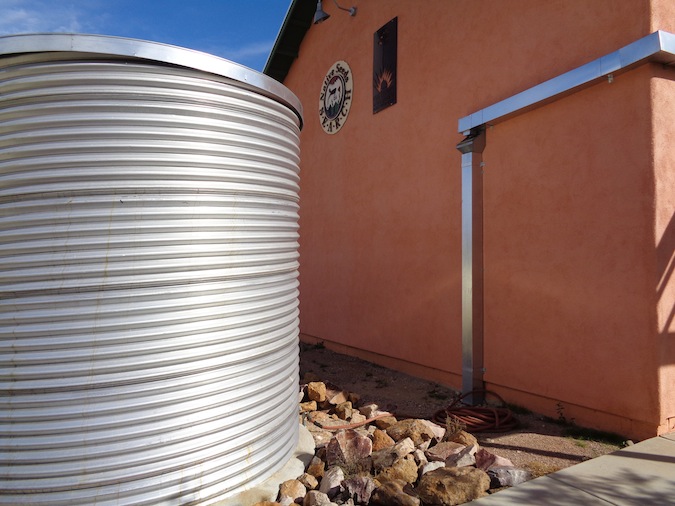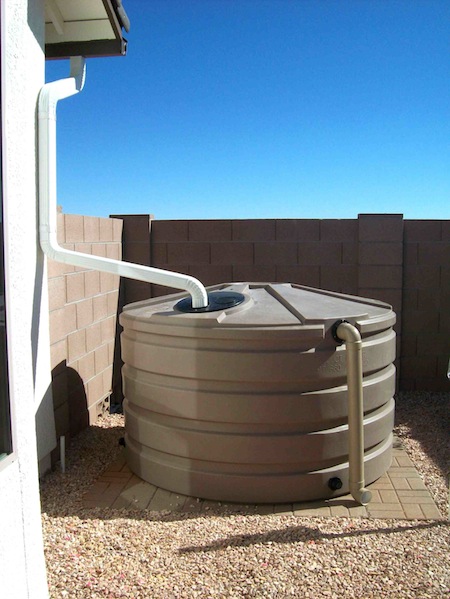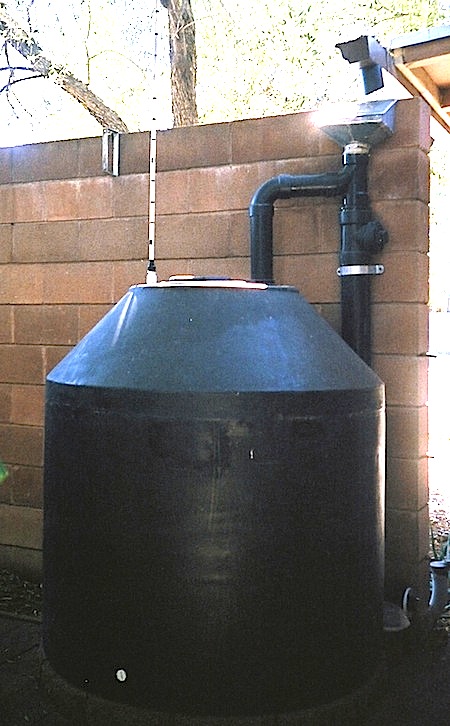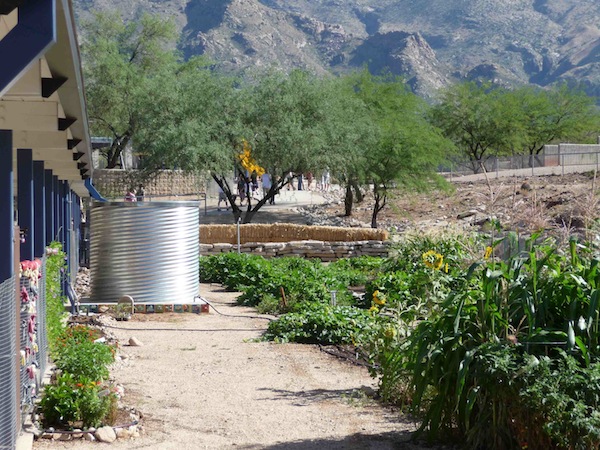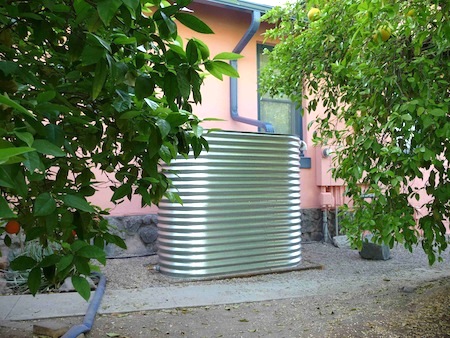Harvest Water in Rainwater Tanks Click Here for a PDF of Harvest Water in Rainwater TanksHaving made the most of passive water harvesting, consider collecting rainwater runoff from roofs into tanks to allow you to store rainwater for later use—a strategy sometimes called active water harvesting. Follow rainwater harvesting principles for tanks for efficient and safe design. Tanks can be placed above ground or underground, and range from 50 gallons to tens of thousands of gallons in capacity. Tanks are available in plastic, metal, fiberglass, concrete and other materials. If the water level in a tank is higher than the ground level of a tree-planting site you want to water, a valve or hose bib installed in the tank can allow delivery of tank water via gravity flow. Install the tank tap ≥ 4 inches above the bottom of the tank to reduce disturbance of any sediment in the bottom. You can attach a garden hose to distribute water to trees, or install a permanent pipe and rainwater faucet close to trees to make rainwater convenient to use. If the tank water level is lower than the ground level of trees that need water, or if pressurized flow is needed for a drip irrigation system, use a pump to deliver water. |
Metal tank is filled with rainfall runoff from a large roof through an adjacent gutter and downspout. Water is conveyed down the wall and underground into the tank in a water-tight pipe. Tank is tapped with a hose bib. A garden hose delivers water to a nearby landscape via gravity flow. The tank is positioned away from the building to protect the foundation in case the tank leaks. |
Any roof runoff that exceeds the capacity of the tank should flow out of the tank though an overflow pipe installed near the top of the tank. Direct overflow water toward beneficial uses such as into passive depressions. These depressions should also have overflow routes to direct water out in large storms. Rainwater quality in tanks is affected by the air the rain passes through, the roof materials that rain flows over, and the materials used in piping and tank construction. Storage of water in tanks can concentrate particles washed off roofs, so keep roofs and gutters clean. Installing a pre-tank filter can deflect leaves and other detritus coming off the roof, keeping these out of the tank. Installing a first flush device can deflect a small volume of initial roof runoff and detritus away from the tank at the beginning of each rainfall event, then allow subsequent runoff to flow into the tank. Choose pipes, tank materials, filters materials, and other components to help yield high quality stored water. To keep critters, mosquitos and other insects out of tanks, screen all inlets and outlets on the tank. Besides storing rainwater, above ground tanks can provide shade, serve as supports for trellises, act as privacy barriers, moderate hot and cold temperature extremes for trees planted around them and provide other benefits to a site. Decide what type and size tank you need and where to put it based on roof material, roof area and downspout locations; how much water your trees need; available space for a tank, and cost. A larger tank could enable harvesting larger rainfalls and provide greater storage capacity to withstand long dry spells or droughts. Not all the rain that falls on a roof will be available to harvest. See example rooftop and tank calculations here. | RAINWATER HARVESTING PRINCIPLES FOR TANKS
|
Newly installed plastic tank with downspout, filter screen on top of the tank, and overflow pipe. Next steps: extend the overflow outlet pipe away from the tank to a water harvesting depression and attach a valve to tap water via gravity flow. |
Small volume plastic tank with downspout filter and first flush diversion pipe installed. |
A large galvanized steel rainwater tank is filled from a porch roof and waters the adjacent garden using gravity flow. Since tank elevation is too low to gravity feed water to higher elevation trees, a pump could be added to create sufficient pressure to water higher elevation plants. |
ADDITIONAL RESOURCES Selection and sizing of tanks: Rainwater Harvesting for Drylands and Beyond, Brad Lancaster, Water harvesting calculationsTexas A&M AgriLife Extension, tank calculators Vendors sell and install tanks all around Arizona. Search the Internet for local listings of “rainwater tanks” to find sources in your area. |
A “slimline” metal tank fits in a narrow space on a small urban lot where it waters adjacent fruit trees and helps moderate temperature extremes. |
CAUTION: Never eat anything that is not properly identified. It is your responsibility to ensure that all fruits, nuts, seeds, pods and other edible products of trees and shrubs are correctly identified and safe to eat before eating them or serving them to others.
Copyright 2023
LEAF is under the fiduciary stewardship of the Arizona Community Tree Council, a 501(c)3 non-profit organization.
70 S Val Vista Drive, Suite A3-186, Gilbert, AZ 85296

